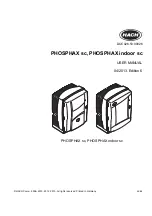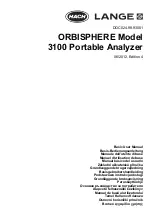
TM 11-6625-1576-15
Section IV
Paragraphs 4-36 to 4-45 and Figure 4-6
Figure 4-6. Rejection Amplifier Block Diagram and Typical Frequency Rejection Characteristic
first stage of amplification, A3Q4, is a field effect
transistor which amplifies the difference signal between
the gate and the source.
The field effect transistor
is selected for maximum noise performance with the
high impedances of the Wien bridge circuit. The signal
from the drain is applied to the two stage feedback am-
plifier A3Q5 and A3Q6. The output of A3Q6 is coupled
to the meter circuit by the post attenuator S3R1 through
S3R11. Negative feedback from the output of the bridge
amplifier is applied to the preamplifier circuit to nar-
row the frequency rejection characteristic. It can be
noted from the rejection characteristic (refer to Figure
4-4) for the bridge that the rejection of harmonic volt-
ages is not constant. Typically the second harmonic
is attenuated several db more than the third harmonic
and the third more than the fourth. The result of the
negative feedback is illustrated by the rejection charac-
teristic shown in dashed lines on the attenuation and
phase characteristic of Figure 4-4. Figure 4-6 shows
a simplified block diagram of the rejection amplifier
with the typical frequency-rejection characteristic.
Refer to Figure 4-7, Bandwidth Versus Null Depth for
further detail on the rejection characteristic.
4-37. The HIGH PASS FILTER (see Figure 6-3) is
normally used when the fundamental of the input signal
is greater than 1 Kc.
In the voltmeter mode of opera-
tion, the filter is not used. In the SET LEVEL and
DISTORTION position of the FUNCTION switch the
filter presents >50 db attenuation to 50 or 60 cycle
hum components, but offers no attenuation to frequen-
cies over 1 Kc.
The filter assembly, A7, consists of
A7C1, A7C2, and A7L1. The filter can be inserted
or bypassed by the HIGH PASS FILTER switch, S9.
4-39. The meter circuit (refer to Figure 6-4) consists
of the post attenuator, the meter amplifier circuit,
and the meter rectifier circuit.
4-40. POST ATTENUATOR.
4-41. The post attenuator, S3R1 through S3R11, is a
series of resistive networks which attenuate the input
signal in 10 db steps.
The attenuator is used in con-
junction with either the input sensitivity attenuator or
the 1000:1 attenuator to limit the signal level to the
meter amplifier to 1 mv for full scale deflection on
all ranges from 1 mv to 300 v full scale. The meter
circuit sensitivity is increased to 300 uv for full scale
deflection on the 300 u
V
range by switching resistors
A2R29 and A2R30 into the calibration network. Resis-
tor A2R41 and capacitor A2C29 are also switched into
the calibration network on the 300
P
v range to extend
the passband of the amplifier.
4-42. METER AMPLIFIER CIRCUIT.
4-43. The meter amplifier circuit consists of a five
stage amplifier circuit, A2Q5 through A2Q9, which
develops the current for full scale meter deflection.
Negative dc feedback from the emitter circuit of
A2Q8 is applied to the base of A2Q5 to stabilize the
dc operating point of the meter amplifier circuit and
to minimize the tendency for dc drift due to ambient
temperature changes. A2R51 and A3CR8 are electric-
ally in the circuit only when the meter circuit is over-
loaded. When the voltage on the emitter of A2Q9 be-
comes abnormally large during an overload, A2CR8
breaks down and provides a lower resistance charging
path for A2C15 which reduces the transient recovery
time of the meter circuit. Negative ac feedback is
applied from the collector circuit of A2Q9 to the emit-
ter circuit of A2Q5. This feedback is used to ensure
flat frequency response, to improve linearity, and to
reduce the effect of variation of transistor parameters
with environmental changes. In this manner, the
calibration of the instrument is made dependent on
high quality passive components.
4-44, METER RECTIFIER CIRCUIT.
4-45. The meter rectifier is connected in a bridge type
of configuration with a diode in each upper branch and
a dc milliammeter connected across the midpoints of
the bridge. The simplified meter rectifier is illu-
strated in Figure 4-8.
The generator represented by
A2Q5 through A2Q9 with the internal impedance R
O
provides the meter, M1, with current for full scale
deflection and develops a voltage across the calibration
network which closes the ac feedback loop. Capacitors
A2C27 and A2C28 are used as coupling capacitors for
the ac feedback loop, output signal to the OUTPUT
connector, and the bridge error signal to the input of
the automatic fine tuning loops. The mechanical inertia
of the meter and A2C26 prevents the meter from re-
sponding to individual current pulses.
Therefore,
the meter indication corresponds to the average value
of the current pulses rather than the peak value. The
meter is calibrated to indicate the rms value of a sine
wave. Resistor A2R45 impresses a fixed bias across
diodes A2CR6 and A2CR7 (biasing them close to the
barrier voltage) to make the meter circuit response
linear to large variations in signal amplitude. The
linearity of this type of circuit is also increased by
including the meter circuit in the overall feedback
loop.
Summary of Contents for 333A
Page 4: ......
Page 6: ...TM 11 6625 1576 15 Section I Model 333A 334A Table 1 1 Table 1 1 Specifications Cont d 1 2 ...
Page 8: ......
Page 10: ......
Page 24: ...TM 11 6625 1576 15 Section V Table 5 1 Model 333A 334A Table 5 1 Test Equipment Required 5 0 ...
Page 36: ...TM 11 6625 1576 15 Section V Table 5 8 Model 333A 334A 5 12 ...
Page 38: ...TM 11 6625 1576 15 S e c t i o n V T a b l e 5 9 Model 333A 334A 5 14 ...
Page 44: ......
Page 45: ......
Page 46: ......
Page 47: ......
Page 48: ......
Page 49: ......
Page 50: ......
Page 51: ......
Page 52: ......
Page 53: ...PIN 016265 000 ...
















































